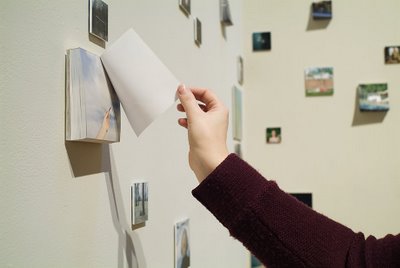Sonja Thomsen
Thursday, 7 May 2009
“There is more genetic complexity in a milliliter of water than the whole of the human genome. This is what Sonja Thomsen told me when we first met, about four years ago, and the sort of thing she thinks about a lot.That such an immense universe of organisms could be contained in something so elemental and small fascinated her and informed what was then new work: photographs of the surfaces of water.She has far from exhausted the potential of these rich, liquid landscapes, and has recently begun exploring the mysterious and seductive nature of petroleum as well.Her subtle abstractions of water and oil are resonant with ideas about scarcity and global politics, and the reflective quality of the work invites self-examination, including from the artist, whom we occasionally see as a silhouette, her hair falling around her face and camera.Water has become an apt metaphor for Thomsen’s creative voice. Like our constantly altering lake, her presence has a sort of clear invisibility to it. In other words, it is defined by the way it reflects the world around her.Which is why her most recent project, “Lacuna,” now on view at the Haggerty Museum of Art along with one of her major oil pieces, feels like such a departure.Thomsen is one of 10 artists in the Haggerty’s “Current Tendencies,” a survey of contemporary Wisconsin art. She earned bachelor’s degrees in art and biology from Kenyon College in Ohio, a master’s in fine art photography in 2004 from the San Francisco Art Institute and is an adjunct professor at the Milwaukee Institute of Art & Design.In “Lacuna,” her point of view remains beautifully tentative but personal. She has a large family, a tribe that gets together in big, chaotic, wonderful confabs. Many of them frequent “Lacuna,” which includes 70 or so images scattered across two walls in varying sizes and in distinct groups and sequences.”What I’m trying to pursue is how I can have these images communicate the idea of the intangible or communicate the suggested narrative rather than being specifically sentimental,” she’s said in a podcast at her blog.The word lacuna means an unfilled space or gap in knowledge, literature or bone.Often, it is more than empty space. It’s a holding place for something that once existed, like the fragment of a manuscript or a memory.Thomsen says she started hoarding the “Lacuna” imagery when her grandfather and father-in-law began experiencing dementia. Personal traumas have, she says, inspired shifts in her work.When her grandparents had to give up living in their home of 40 years, they stubbornly refused to leave until they had harvested the last of the raspberries growing in the yard.One of Thomsen’s images is of her grandfather’s hands and the last of the berries, gathered up in a square cake pan. The pan is centered against the lush green of the bushes, which fall quickly from focus and are denuded of their fruit. A garage sale price tag on the pan is a reminder of that moment of transition. She also included an image of the back of her grandfather’s head, with a beautiful, blurry whiteness beyond.There also are images of intimates and familiar landscapes. One is of a simple, homemade gate, another of the vulnerable gaze of a close friend. There’s the boy with his tub of worms, the lily pad-like ice formations in the lake and the series of hands presenting specimens from nature, like a feather or water creature.”The series with the hands, . . . I would go for walks with people and they would be like ‘Photograph this’ or ‘Look at this,’ ” she said, likening that act of discovering to her own photography. “Even if it was fairly ordinary, in that moment it was like magic.””Lacuna,” which is at least in part about the nature of forgetting, feels a lot like the act of remembering. Some images are high on the wall, some are isolated, others are quite small. We strain to see, to fit the pieces together, to make connections. Memory is a necessary tool for looking at the dispersed imagery.Some images hang on the wall in stacks, like small tablets. We are invited to peel an image away and take it with us. The images fade as the stacks diminish. When the pages are gone, what’s left is an outline etched onto a piece of glass, an opaque, fixed after-image.Thomsen has created beautiful objects in their own right, studies in light, form and line.The roundness of one young man’s shaved head and the pale pink of his lips contrasted with his muscular arm and craggy brush behind him.The continuous sloping line of hand, hair, cheekbone and arm in the very Sally Mann-like image of a young woman looking directly at us with a sense of knowing unease.The muddy field that recedes into an impenetrable white fog. The thick, perfectly horizontal branch, caught in the saplings. The way it holds the snow like a suspended white line.But they are more than aesthetic excursions.Thomsen doesn’t like to articulate what her work is “about,” though she admits she envies some of her students who stake a claim to meaning quickly and boldly.More than memoir and more than renderings of things, Thomsen’s images are acts of devotion. They are evidence of a humane artist developing a new visual vocabulary. Charged with quiet metaphor, they betray a set of treasured beliefs about youth and sensuality, about nature and wonder, about aging and loss.The mingling and sequencing of conceptual, pictorial, narrative and physical lacunae create a form of open storytelling, as much like literature as anything else.” – Milwaulkee Journal Sentinel, Apr. 23, 2009. – Mary Louise Schumacher




